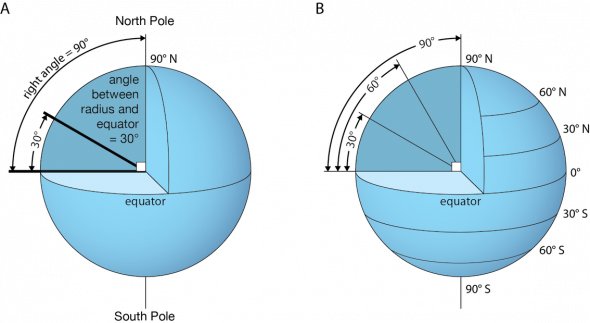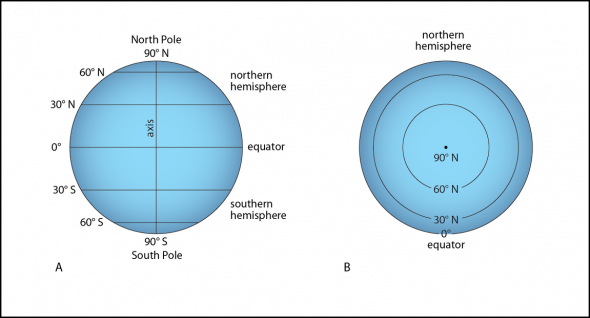Draw a Divided Circle to Represent Earth Climate
When describing location, it is common to mention the city, state, or country as a location descriptor. It is also common to talk about landmarks that may be nearby. Some other way to depict location is to use reference lines to describe coordinates, or absolute position, on the globe.
Ii types of imaginary reference lines are used to locate positions or points and to brand accurate globes and maps. These lines are chosen parallels of latitude and meridians of longitude. Two of these imaginary reference lines, the equator and the prime height, are called primary reference lines considering they are where we start the numbering organisation.
Equator, Hemispheres, Axis, and Directions

The globe rotates daily near its axis. The north and south poles are the ii imaginary points where the centrality would enter and go out from the earth if the axis were a pole or a line (see Fig. 1.9). The equatoris the imaginary primary reference line drawn around the world halfway betwixt the due north and south poles. The half of the earth to the north of the equator is the northern hemisphere; the one-half to the south is the southern hemisphere (Fig. 1.9). (The prefix hemi- ways "half"; thus, hemisphere means "one-half-sphere.") The poles determine north and south directions. Movement toward the North Pole is northerly in direction. Movement toward the South Pole is southerly in management.
Parallels of Latitude
Latitude is measured in degrees (°)—from 0˚ to 90˚—northward or due south of the equator. Degrees of breadth are measured from an imaginary indicate at the centre of the earth. If the earth was cut in half, this imaginary point would be intersected past a line drawn from the North Pole to the South Pole and past a line drawn from the equator on one side of the earth to the equator on the other (Fig. ane.10 A). A radius is a line drawn from the edge of a circle to its center. The angle between the radius lines drawn from the equator and from the north pole (or due south pole) forms a right bending, which is xc°.

The equator is at 0°, and both of the globe'due south poles are at 90° from the equator. Breadth is adamant by the bending betwixt a point on the earth's surface and the equator. To calculate the bending, draw a line from the point to the center of the globe and a line from the equator to the center of the globe (Fig. 1.10 A).
Parallels of latitude are imaginary reference lines that form complete circles around the earth parallel to the equator and parallel to each other. Every bespeak on a parallel of breadth is the same distance from the equator, and thus the bending formed between the equator and the latitude line is constant. This is shown in Fig. i.ten B for the latitude lines 30° and lx° due north.
Parallels of latitude are circles of different sizes (see Fig. i.11). The largest parallel is at the equator, and the parallels decrease in size towards the poles. Except for positions located right on the equator (0°), parallels of breadth are described by the number of degrees that they are n (Due north) or southward (Due south) of the equator. The greater the altitude from the equator, either due north or south, the higher the latitude. Honolulu, Hawai'i, for example, is on the 21° N parallel. Sydney, Australia, is on the 34° Southward parallel.

Meridians of Longitude
Meridians of longitude are imaginary half-circles running from the North Pole to the S Pole. They are sometimes chosen lines of longitude. Unlike parallels of breadth that are unlike sizes, all lines of longitude are the same length. Since every top must cantankerous the equator, and since the equator is a circle, the equatorial circle can be divided into 360°. These divisions of the equatorial circle are used to label the meridians.
By international agreement, the 0˚ meridian (also called the prime meridian) is drawn through Greenwich, England. Meridians are numbered due east and west from the prime top (Fig. 1.12 A).


Longitude is the distance east or west of the prime pinnacle, and longitude is measured in degrees from 0˚ to 180˚ (Fig. 1.12 B). Places to the due east of the prime summit take east longitude. Rome, Italy, for example, is located on the 12˚ East summit, whereas Washington DC, Usa, is located on the 77˚ W meridian.
East and west longitude meet at the 180˚ meridian, which runs through the Pacific ocean basin (Fig. ane.xiii). Therefore, well-nigh of the The states (including Hawai'i) lies in the western hemisphere. Merely a small portion of Alaska (function of the Aleutian Islands) crosses the 180˚ meridian into the eastern hemisphere. The consummate circumvolve effectually the world made by the prime pinnacle (0˚) and the 180˚ top divide the globe into eastern and western hemispheres (meet Figs. one.12 and i.13).
International Date Line

The international date line is an imaginary line running mostly along the 180˚ summit (see Fig. 1.fourteen). The international date line determines where on globe the date changes. For example, at the same moment the time is 6:00 am on July 1st in Bangladesh, the fourth dimension is six:00 pm on June 30th in Mexico and midnight on June 30th in England (see Fig. 1.15 A).
Places located immediately to the right and left of the date line are 24 hours apart. This means that on the left side of the international date line in Tonga, when the time is noon on Mon, July 1st, on the right side of the date line in Sāmoa, the time is noon on Sunday, June 30th (see Fig. i.15 B).


Travelers who cantankerous the dateline heading west lose a day, just travelers who cantankerous the dateline going east gain a day. When traveling eastward beyond the dateline, it is really possible to arrive at your destination earlier than when you left!
For practical purposes, the international date line has been adjusted to allow certain country areas to remain together in the aforementioned 24-hour interval and time zones. For example, the extreme eastern tip of Russian federation, which juts into the Bering Strait, was kept in the easternmost time zone, whereas the U.S.-owned Aleutian Islands were kept as office of the westernmost fourth dimension zone (come across Fig. ane.15 B).

In some other example, the land of Republic of kiribati (pronounced KIRR-i-bas) drastically changed the engagement line in 1995 and so that the entire land could exist on the same day at the same time. Earlier this, the western role of Kiribati, where the capital lies, would be 22 hours ahead of the eastern portion of the county. Now eastern Kiribati and Hawai'i, which are located shut to the same longitude, are a whole mean solar day autonomously (see Fig. ane.16).
Location

Lines of latitude and longitude form an imaginary global filigree system, shown in Fig. one.17. Whatever point on the globe can be located exactly by specifying its latitude and longitude. This system is essential for ships at bounding main that cannot locate their positions using landmarks or littoral navigational aids such as buoys or aqueduct markers. This organisation is but as useful for people on land when hiking, driving, or surveying an environment.
To locate a point on a earth exactly, degrees of latitude and longitude are further subdivided into minutes and seconds. In breadth and longitude measurements, minutes and seconds do non refer to time. Instead, they refer to parts of an angle. But, similar with fourth dimension, at that place are threescore minutes in a caste (just as there are 60 minutes in an hr). Similarly, there are 60 seconds in a infinitesimal of time and 60 seconds in a infinitesimal of longitude or latitude.
1 degree (i°) = 60 minutes (60')
ane infinitesimal (i') = 60 seconds (60")

The latitude and longitude readings of a place are called its spherical coordinates. For example, the coordinates of the location of the USS Arizona Memorial in Pearl Harbor (Fig. 1.18) are "latitude 21 degrees, 21 minutes, and 54 seconds north; longitude 157 degrees, 57 minutes, and goose egg seconds due west." This is written equally "21° 21' 54" Due north, 157° 57' 0" Due west".
Activity: Locating Points on a World
Make a globe marked with reference lines of latitude and longitude.
Activeness: Mapping the Globe
Brand three maps of a world: an orthographic-projection map, a cylindrical-projection map, and an equal-area map.
Breadth and Longitude Utilise
If the latitude and longitude coordinates of a location are known, it can be pinpointed on a map or world. Knowing the spherical coordinates of a location is useful for people when hiking, diving, or surveying an surroundings. Sophisticated navigational aids use latitude and longitude to give directions when driving and flying. The spherical coordinate system is essential for ships at body of water that cannot locate their positions using landmarks or coastal navigation aids like buoys or channel markers.
Nautical Miles and Knots
In addition to using latitude and longitude to specify location, marine and air navigators also use the nautical mile as their unit of length or distance. A nautical mile is approximately one minute of latitude along a line of longitude, a distance of ane.85 kilometers. Navigators describe the speed of ships and airplanes in knots. Meteorologists likewise describe air current speeds in knots. I knot is equal to one nautical mile per hr.
ane nautical mile = 1.85 km
1 knot = i nautical mile/hour
Activity: Pacific Scavenger Hunt
Complete a location scavenger hunt using a map of the South Pacific ocean basin.
Source: https://manoa.hawaii.edu/exploringourfluidearth/physical/world-ocean/locating-points-globe
0 Response to "Draw a Divided Circle to Represent Earth Climate"
Post a Comment